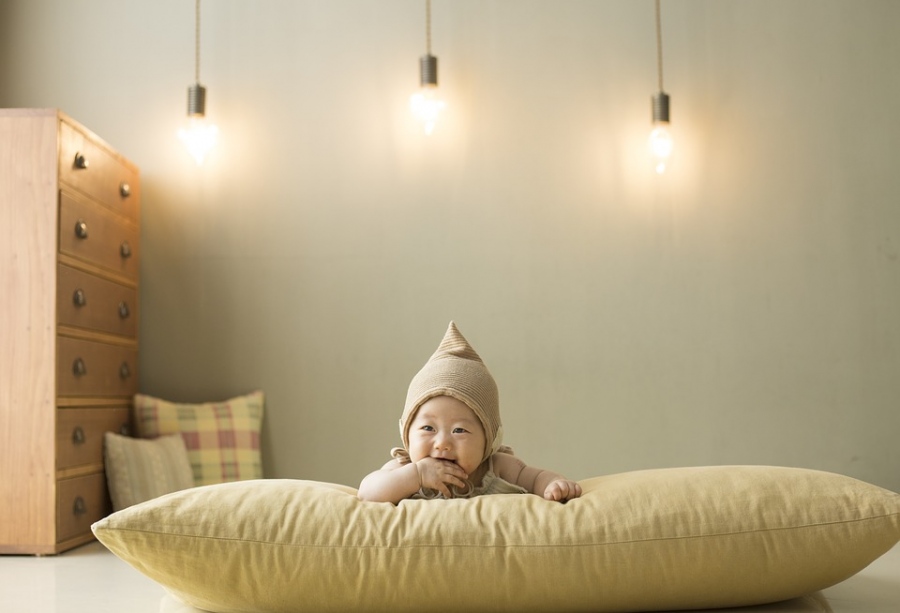Colors for a baby’s nursery can be tricky to choose. Few people still prefer to use the old standard gender colors of pink and blue, so many parents leap into the world of color based on their own interest or simply because it looks good on the sample card. It’s not exactly a science. In fact, marketers say color does influence us and have spent millions of dollars trying to determine just how it affects our mood and behavior or how it can stimulate the brain and affect one’s health.
Researchers have found that color influences mood and can affect the way we sleep. Color can improve memory power, and in children, can improve their academic performance. Yes, we all want this for our kids, but your child is still a baby so how do you get all of these benefits? This doesn’t mean going out and painting the whole room purple or orange though. Colors have an effect on the mind and body, so you need to choose the baby’s room color carefully.
With so many options available for a painting project, it’s important to identify your options so that you can create an environment that your child will enjoy. Before you start with an interior painting project for your newborn baby, below are the advantages and disadvantages of each of the different color categories available.
Warm Colors
In large, open spaces, warm colors create intimacy by creating a sense of coziness. Most warm colors like reds, oranges, and yellows stimulate the mind and energize the body, but while this is great for growth and development, it may not work when it comes to bedtime for your little one. So rather than painting the entire room red or yellow, paint an accent wall and add matching accessories when you want some warmth but not too much. Also, make sure that the furniture in the room doesn’t clash with the paint color that you have selected.
Bright Colors
Little girls love pink because it makes them feel beautiful. Pink is the color of femininity. However, it is a color that can become irritating over time. So, tone it down to a lighter color or use it sparingly in the room. Consider using a combination of pink and white to make the walls easier on the eyes. Incorporating stripes can be a great way to add some variety to the room as well.
Yellow is associated with motivation and happiness. Concentration is improved with soft, subtle yellows, while brighter shades stimulate memory and metabolism. Too much yellow, on the other hand, causes anger and frustration. This could cause your newborn to become stressed, over-stimulated and fussy, so be careful as to the tone of yellow you use and the amount you use. You might instead choose to use yellow accents or paint just one wall a pale yellow to get that stylish look. Make sure that there are blinds in the room to prevent light from reflecting off of the bright colors.
Cool Colors
Your child’s room can feel spacious and relaxing with cool colors. Think of the horizon, the sky, and the ocean with cool colors. Just be sure to keep them light, as dark, cool colors can bring a feeling of constraint, sadness, and depression, so use cool light colors or use them in accents.
Blue
Blue sits on the opposite side of the color wheel to red; So, it works in an opposite way to red. It calms the heart rate, increases the baby’s respiration, and can reduce their anxiety. Spending time in a blue environment may benefit children who have problems with anxiety, poor sleep, and crying. Blue’s cooling properties also have a calming and cooling effect in homes that are in hot, humid climates.
Purple
Purple is the combination of blue and red, so it can take on the properties of either color depending on the amount of blue or red in the shade. Additionally, purple is often associated with royalty and wealth.
Green
Nature is symbolized by green, and this color has a calming sensation. Green is the color of health and healing. For babies, it is a great color because it soothes them. A light green, or accents in forest green could help reduce your baby’s anxiety and depression.
Proper Application
One of the most important parts of any interior painting project is applying your paint correctly. Using the wrong supplies could expose your child to cheap paint that produces toxic fumes. In addition, cheap paint may not last as long compared to quality supplies. To avoid these problems, work with a professional to ensure that your property is painted with the best tools and supplies available. An interior painter will be able to help you determine what kinds of paint will best suit the room.
Trusting Your Feelings
Even though the above mentions the science and psychology of color, keep in mind that these are just generalizations. Responses are also personal and cultural. Colors can be a cultural thing, and if a particular color influences you in a certain way because of your heritage, that is okay. So, if you and your little one love red, don’t worry about what other people think. Use it to your delight. A person can enjoy many colors. So, if your baby is happy with a certain color use that for their room.

